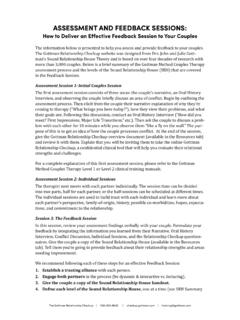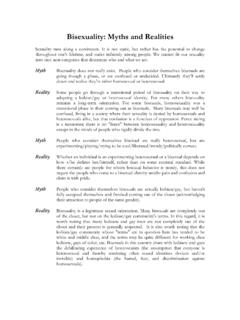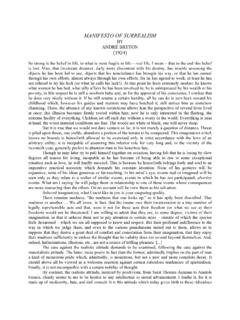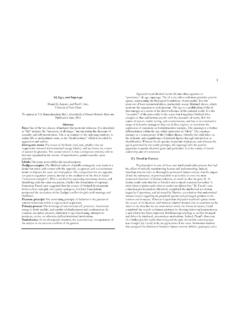Transcription of Gestalt therapy - Counselling Connection
1 A GUIDE TO Counselling THERAPIES (DVD) Gestalt therapy Published by: J & S Garrett Pty Ltd ACN 068 751 440 All Case Histories in this text are presented as examples only and any comparison which might be made with persons either living or dead is purely coincidental Page 2 of 9 A GUIDE TO Counselling THERAPIES (DVD) Gestalt therapy CONTENTS HISTORY .. 3 KEY 3 GENERAL IDEAS ABOUT PERSONALITY 4 THERAPEUTIC TECHNIQUES & METHODS OF WORKING .. 5 7 STRENGTHS AND WEAKNESSES .. 8 CONCLUSION .. 8 9 Page 3 of 9 Gestalt Prayer I do my thing and you do your thing.
2 I am not in this world to live up to your expectations And you are not in this world to live up to mine. You are you and I am I, And if by chance we find each other, it s beautiful. If not, it cannot be helped. (Fritz Perls, 1969, in Gladding, 2000) HISTORY Gestalt therapy was developed in the 1940 s by Fritz and Laura Perls and further influenced by the likes of Kurt Lewin and Kurt Goldstein (Corsini & Wedding, 2000). It was developed as a revision to psychoanalysis and focuses on an experiential and humanistic approach rather than analysis of the unconscious which was one of the main therapeutic tools at the time Gestalt therapy was employed.
3 Gestalt therapy rejects the dualities of mind and body, body and soul, thinking and feeling, and feeling and action. According to Perls, people are not made up of separate components, this is, mind, body and soul, rather human beings function as a whole. In doing so, one defines who one is (sense of self) by choice of responses to environmental interactions (boundaries). The word Gestalt (of German origin) refers to a whole, configuration, integration, pattern or form (Patterson, 1986). The form of Gestalt therapy practiced today utilises ideas, data and interventions from multiple sources, as well as some of the original techniques known to be Gestalt therapy techniques.
4 It is noted that Gestalt therapy has a history of being an approach which creates or borrows specific techniques that are focused on assisting the client to take the next step in their personal growth and development. KEY CONCEPTS Several key concepts underlie Gestalt therapy , many of which are similar to that of person-centred and existential therapy . However, what does differentiate Gestalt therapy from these therapies are some of the ideas added by Perls and associates as well as distinctive therapeutic techniques that will be covered further down (Seligman, 2006). The following are the key concepts of Gestalt therapy : Wholeness and Integration Wholeness refers to the whole person or the individual s mind and body as a unit rather than as separate parts (Seligman, 2006).
5 Integration refers to how these parts fit together and how the individual integrates into the environment. Often people who come to therapy do not have these parts fitting together in their environment, Gestalt therapy is about facilitating clients to integrate themselves as whole persons and help restore balance in their environment. Page 4 of 9 Awareness Awareness is one of the most important elements in Gestalt therapy as it is seen as a hallmark of the healthy person and a goal of treatment (Seligman, 2006). When individuals are aware , they are able to self-regulate in their environment.
6 There are two main causes lacking awareness: y Preoccupation with one s past, fantasies, flaws and strengths that the individual becomes unaware of the whole picture. y Low self-esteem. There are three ways people may achieve awareness through therapy : 1) Contact with the environment This is through looking, listening, touching, talking, moving, smelling, and tasting. This enables the individual to grow in his or her environment through reacting to the environment and changing. 2) Here and now This is the individual is to live in and be conscious at the present moment rather than worrying about the past or the future.
7 3) Responsibility This refers to the individual taking responsibility for his or her own life rather than blaming others. Energy and blocks to energy Gestalt therapists often focus on where energy is in the body, how it is used, and how it may be causing a blockage (Corey, 2005). Blocked energy is a form of resistance, for example, tension in a part of the body, not breathing deeply, or avoiding eye contact. Gestalt therapy is about finding and releasing the blockages that may be inhibiting awareness.
8 Growth Disorders Growth disorders refer to emotional problems that are caused by people who lack awareness and do not interact with their environment completely. In doing so, people are unable to cope with the changes in their lives successfully and, instead deal with the problems in a defensive manner (Seligman, 2006). Unfinished business Unfinished business refers to people who do not finish things in their lives and is often related to people with a growth disorder (Seligman, 2006). People with unfinished business often resent the past and because of this are unable to focus on the here and now.
9 One of the major goals of Gestalt therapy is to help people work through their unfinished business and bring about closure. GENERAL IDEAS ABOUT PERSONALITY DEVELOPMENT Gestalt therapy deems that people cannot be considered as separate from their environment or from interpersonal relations. The individual is seen as being self-regulating and is able to motivate oneself to solve problems. Individuals are able to work towards growth and develop as their environments allow. A psychologically healthy person is someone who is self-Page 5 of 9 regulating through the changes in life and has developed a sense of wholeness between mind and body (Corsini & Wedding, (2000).)
10 THERAPEUTIC TECHNIQUES & METHODS OF WORKING GOALS OF therapy The most important goal of Gestalt therapy is that Gestalt therapists do not aim to change their clients. The therapist s role is to assist clients in developing their own self-awareness of how they are in the present moment. This will therefore allow them to rectify issues affecting his or her life. The therapist s job is to invite clients into an active partnership where they can learn about themselves by adopting an experiential attitude toward life in which they try out new behaviours and notice what happens (Perls, Hefferline and Goodman, 1954, in Corey, 2005).















